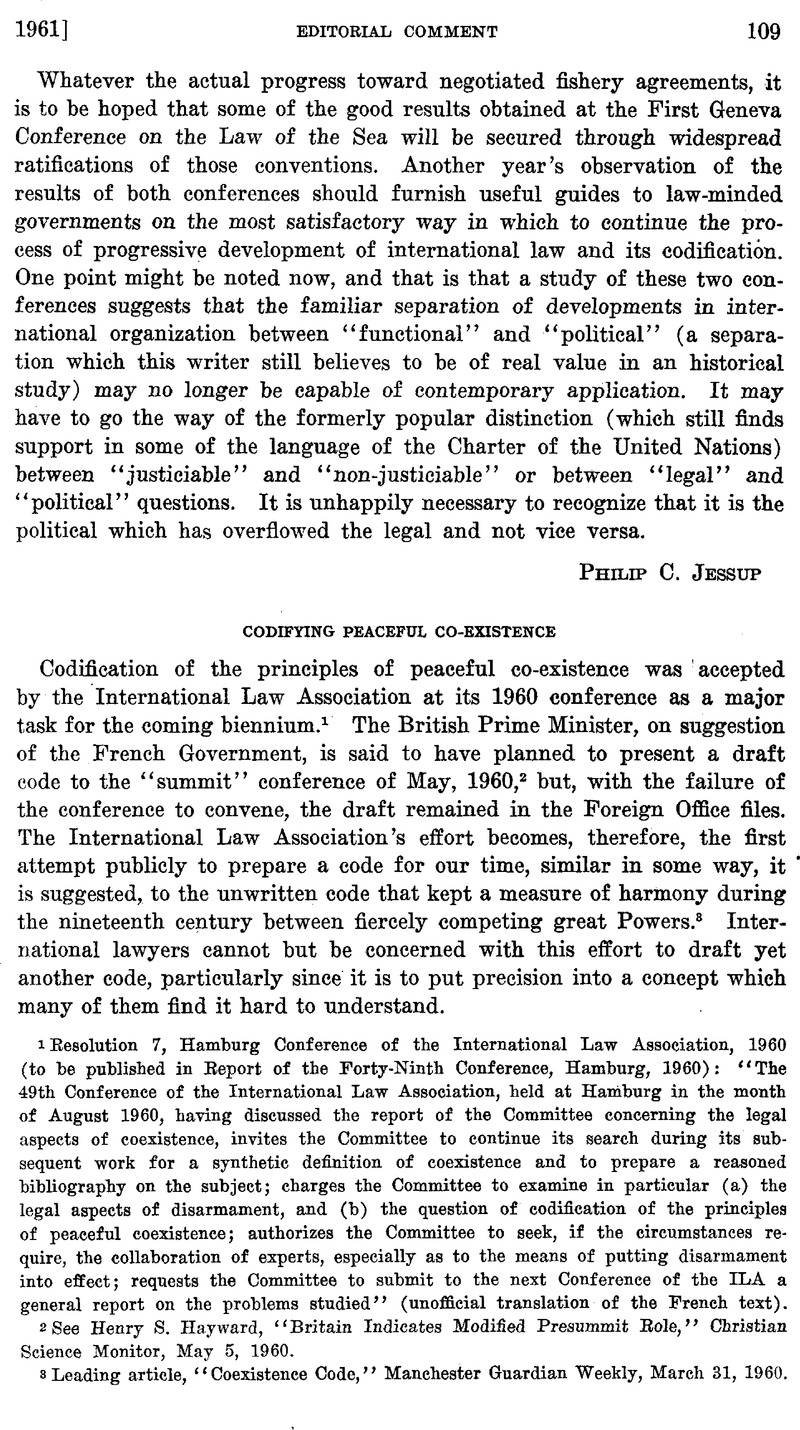Published online by Cambridge University Press: 28 March 2017

1 Resolution 7, Hamburg Conference of the International Law Association, 1960 (to be published in Report of the Forty-Ninth Conference, Hamburg, 1960): “The 49th Conference of the International Law Association, held at Hamburg in the month of August 1960, having discussed the report of the Committee concerning the legal aspects of coexistence, invites the Committee to continue its search during its subsequent work for a synthetic definition of coexistence and to prepare a reasoned bibliography on the subject; charges the Committee to examine in particular (a) the legal aspects of disarmament, and (b) the question of codification of the principles of peaceful coexistence; authorizes the Committee to seek, if the circumstances require, the collaboration of experts, especially as to the means of putting disarmament into effect; requests the Committee to submit to the next Conference of the ILA a general report on the problems studied” (unofficial translation of the French text).
2 See Henry S. Hayward, “Britain Indicates Modified Presummit Role,” Christian Science Monitor, May 5, 1960.
3 Leading article, “Coexistence Code,” Manchester Guardian Weekly, March 31, 1960.
4 See Int. Law Ass’n, Report of the Forty-Seventh Conference, Dubrovnik, 1956, pp. 17-S9.
5 The committee was chaired by Me. Henri Cochaux (Belgium) ; with Prof. M. Radojkovié (Yugoslavia) as rapporteur, and members representing the Branches of the United Kingdom, the U.S.S.R. and the U.S.A.
6 See Int. Law Ass’n, Report of the Forty-Eighth Conference, New York, 1958, pp. 443-446.
7 Resolution 7, ibid., pp. xiii-xiv.
8 Report of the Committee on the Juridical Aspects of Co-Existence, printed provisionally as a conference document; to appear finally in Report of the Forty-Ninth Conference, Hamburg, 1960.
9 For a history of the term, see Communication de Me. Henri Cochaux, loo. cit. note 6 above, at 468-484. The history makes clear that the term is being given a new meaning and is to be distinguished from the term utilized in the Lotus case by the Permanent Court of International Justice.
10 See N. S. Khrushchev’s speech at Andrews Field on arrival in the U.S.A., Sept. 15, 1959, Khrushchev in America 13 (1960).
11 For an account of the UNESCO debate, see Hazard, John N., “Legal Research on ‘Peaceful Coexistence,’” 51 A.J.I.L. 63 (1957)Google Scholar.
12 See Peaceful Coexistence: A New Challenge to the United Nations. Twelfth Report, Commission to Study the Organization of Peace, Arthur N. Holcombe, Chairman (June, 1960).
13 See Proceedings and Committee Reports of the American Branch of the International Law Association, 1957-1958, p. 85 at 93 (1958).
14 See Tunkin, Grigory I., “Coexistence and International Law,” 95 Hague Academy Recueil des Cours 6 (1958, III)Google Scholar.
15 See Milan Bartoš, “Quelques Observations sur la Coexistence Pacifique Active,” 7 Jugoslovenska Eevija za Medunarodno Pravo 216 at 218 (1960).
16 See Miloš Radojković, “La Coexistence,” ibid. 205 at 207.
17 See Drew Middleton, “West Will Press Code of Principle,” New York Times, May 11, 1960.
18 See Bartoš, loc. cit. note 4 above, at 18, and Report of American Branch Committee, cited note 13 above, at 86.
19 See Report of American Branch Committee, ibid, at 92.
20 This view requires rejection of the argument of Paul Bastid that peaceful coexistence requires renunciation of any idea of crusade. See P. Bastid, “Les principes juridiques et moraux de la coexistence,” Bulletin Interparlementaire, 1955, No. 1, p. 4. One cannot imagine that impassioned statesmen will abandon crusades which seem to them essential to achievement of the good society. The most that can be achieved is a channeling of the crusade so that it takes the form of exhortation to emulate rather than incitement to revolution and the giving of military aid.